
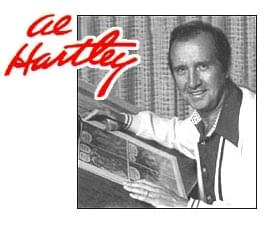
Al Hartley (USA) Allan Hartley was born in 1921, in Kearny, New Jersey, the son of Rep. Frederick Allan Hartley, Jr. The senior Hartley was a Republican from New Jersey who became the youngest member of the U.S. House of Representatives in 1929 and is best remembered for drafting what has become know as the " Taft-Hartley Act of 1947 ," a Management-Labour bill which outlawed the closed shop, imposed criminal penalties for corruption, prohibited secondary boycotts, and allowed states to pass right-to-work laws. Like so many other successful cartoonists, Al Hartley started drawing when he was very young. Eventually he studied at the Art Students League
While many people may remember him for his work on the " Archie Christian comics " ( Spire/Barbour Christian Comics ) of the 1970s, Hartley had a long career in both commercial art and secular comics prior to that time, working for major comics publishers Atlas/Timely/Marvel , Quality, American Comics Group/ACG, and Better/Nedor/Standard alongside such well known artists such as L.B. Cole, Russ Heath, Dave Berg, Dan DeCarlo, Dick Ayers, Syd Shores, and Jack Kirby . Hartley's earliest comics work began appearing immediately after the end of the war, in 1945, when he began freelancing for editor Stan Lee at Atlas/Timely/Marvel Comics, drawing the "Patsy Walker" feature in Miss America Magazine ("The Largest Selling Teen-Age Magazine - More Than 1 Million Copies"). This was also the beginning of a two decade long association with the "Patsy Walker" character, in collaboration with writer/editor Lee.
Other work during this time included: "Zippie" back-up features in both The Fighting Yank (1947) and Johnny Hazard (1948) for Better/Nedor/Standard; the "Debbie" (shown at right) and "Teen Tales" features in t he bimonthly Cookie, The Funniest Kid in Town comic published by Michel Publications (part of the American Comics Group or ACG) from 1947-48; the "Peg" feature in The Kilroys comic published by ACG in '48; and artwork in the Andy comic for Current Publications (Ace Magazines) that same year. By '48 he was also working on the actual Patsy Walker title with Lee as well as on Atlas/Timely/Marvel's Nellie the Nurse magazine.
By 1951 Hartley appears to have been freelancing almost exclusively in comics for Atlas/Timely/Marvel, either writing his own stories or drawing from Stan Lee scripts. Among the titles he worked on for them in the early 1950's were Venus, Suspense, Man Comics, Amazing Detective Cases, Crime Fighters and the "Black Rider" feature in Wild Western. War comics had become very popular, and by 1952 Hartley was "in the thick of it" doing War Adventures, Men's Adventures, Battle, Combat Kelly , Battlefield, and Battlefront (Hartley's cover for issue #10/Mar. 1953 shown at left). He also did covers and interior stories for many romance comics including Love Tales, Love Adventures, Lovers, Love Romances, Girl Comics, Girl Confessions, and My Own Romance.
There appears to be a very small gap in Hartley's output for Lee in early 1955, reportedly due to Atlas/Timely/Marvel becoming backlogged and cutting back on freelancers for a while around August 1954. During this time Hartley did artwork again for Ace Periodicals, some of which appeared in Ace's Ten-Story Love comic in 1955. This cutback must have been fairly brief, however, because Hartley's work was appearing soon after in a large number of romance, western, and mystery titles under the Atlas imprint, such as Secret Story Romances, True Secrets, Meet Miss Bliss, Western Outlaws, Quick Trigger Action, Annie Oakley, Wild Western, Western Gunfighters, Marvel Tales, World of Suspense, Journey Into Mystery, Astonishing, and Mystery Tales.
Around this same time Hartley is reported to have briefly written and drawn a syndicated cartoon panel entitled Suburbia (1957), but the syndicate which distributed it is unknown, as is the reason why it appeared for such a brief period of time. Hartley also provided artwork for Stan Lee's short-lived newspaper comic strip about scouting, Mrs. Lyon's Cubs (shown here, left), after the untimely death of the original artist, Joe Maneely, in 1958. The strip was syndicated by Field Enterprises.
Hartley also put in a 9-issue stint as artist on the bimonthly Linda Carter, Student Nurse title, again working from Stan Lee scripts. The early '60s brought a new "boom" in popularity for superhero titles at (Atlas/Timely) Marvel Comics, and Hartley's career took an unusual turn when Stan Lee asked him to have a go at illustrating one of the new Marvel superhero titles: "The Mighty Thor" in Journey into Mystery #90 (Mar. 1963). Then again, perhaps it is only unusual in hindsight, now that Hartley is known so completely for his work on the "Archie" and "Patsy Walker" characters. At the time Lee would have regarded Hartley (and correctly so) as a very versatile artist who had done terrific work on various war, western, romance, jungle, and humour titles -- whatever was "hot" in the market at the time. So it's possible that Lee thought Hartley could do an equally great job on the new superhero titles and gave him the job on that basis. On the other hand, some have said that it was simply a matter of Lee not having any other work to give Hartley at that moment, due to a backlog in the teen and romance books, and taking a chance on Hartley's work.
However Hartley's work on "Trapped by the Carbon-Copy Man!" written by Stan Lee and Larry Lieber (splash page shown here, left), was not well-received by Lee, and it would be the only time Hartley would draw one of the Marvel superheroes in a complete story in their own book. (Some Internet sources do claim he may have inked -- and/or retouched -- Jack Kirby's pencils on the cover of Fantastic Four #13, April 1963.) Two years later he made a stab at scripting a couple of the Marvel superhero titles, writing "Oh, Wasp, Where is Thy Sting!" featuring Giant-Man & the Wasp in Tales to Astonish #69 (July 1965), which was illustrated by Bob Powell and John Giunta, and on "If A Man Be Mad!" starring Iron Man in Tales of Suspense #68 (Aug. 1965), with art by Don Heck and Mike Esposito (inking as "Mickey Demeo").
Apparently this particular comics genre just wasn't a "fit" for Hartley, and these efforts became the sum total of his work in the Marvel superhero line.
He also wrote scripts for several Western comics around this same time: "The Panther Will Get You if You Don't Watch Out!" in Two-Gun Kid #77 (Sept '65) drawn by Dick Ayers and Carl Hubbell, "They Called Him Coward" in Rawhide Kid # 47 (Aug '65) drawn by Sol Brodsky and Frank Giacoia (as "Frank Ray"), and a "Phantom Rider" story drawn by Jack Keller in Kid Colt Outlaw #124 (Sept '65) which was later reprinted in a 1978 issue of that same title. However Hartley did not need the popular superhero books to make him a success at Marvel. Adverts in his "Patsy" titles were boasting of "five to six million readers" at their peak, reportedly. In all, seven comic book titles were fully devoted to her -- A Date with Patsy, Miss America, Girls' Life, Patsy and Hedy, Patsy and Her Pals, Patsy Walker's Fashion Parade and Patsy Walker (issue #86/Dec. 1959 shown here, right)-- six of these simultaneously, which was far better than Spider-Man or any of the other superhero titles would do during the '60s. Hartley worked on "Patsy" all the way through to the end, in 1967, when the last title in which she was appearing ceased publication. But, by 1967, another significant thing had happened to Hartley. After 20 years of striving for fame and fortune in secular comics he was feeling "sterile, numb, and filled with fear." His marriage was in trouble, his life seemed out of control, and he longed for God to "take hold of my life." He and his wife Hermine attended a prayer meeting together where he heard the pastor say, "Some things are impossible to man, but nothing is impossible to God ."
At time of his conversion in '67, Hartley was drawing another "cheesecake" comic strip called "Pussycat" for a black & white men's magazine, also published by Marvel. When he told publisher Martin Goodman that he could no longer do the feature, and the reasons why he couldn't , he lost all his other assignments and soon found himself completely out of work for the first time in his career. Soon after, another first occurred -- a new client called from "out of the blue" to offer him work, something that had never happened to him before. It was the editor of Archie Comics, and Hartley started drawing for that publishing house, feeling confident that " God had sent them ." "I just loved my work ," Hartley said later. "My wife would hear me in my studio just breaking up over the antics that the characters(shown at left) were going through that day." His enthusiasm for the work showed, and soon he was being asked to write stories as well as illustrate them. Some Archie fans have called him "the best '70s writer," one who had a real talent for handling the individual characters' personalities in skilful and interesting ways.
Then Hartley and the publishers had what they believed to be a God-given idea -- To create completely original comics using the Archie characters. It was, as Hartley put it later, "a fantastic idea for evangelism," but permission had to come from John Goldwater, president of Archie comics, who was Jewish. Hartley had already cultivated a relationship with Goldwater, enjoyed several conversations about faith with him, and found Goldwater to be "a man of deep moral and spiritual principles." (John Goldwater was among those who created the Comics Code Authority in 1954 to help control the way sex and violence were portrayed in comics.) Hartley telephoned Goldwater "with an optimism that had to come from God," and "within one minute" Goldwater had given his approval. Hartley always felt that it was "the Lord's timing" that they had published The Hiding Place comic just prior to his approaching the Archie publisher, because it had "showed John a side of Christianity that few Jews have seen."
Both the secular and Christian media took a great interest in his work on the
Spire Christian Comics series
, and Hartley was interviewed in newspapers like The New York Times as well as Baptist People magazine in July 1973 (shown here, above left). Guideposts magazine featured him on the front cover of their April 1974 issue and in an article entitled "How to Succeed." Fleming H. Revell published a short autobiography of Hartley's conversion to Christianity entitled
Come Meet My Friend
, (shown at right) in 1977. Almost twenty years later his work on these Christian comics was still being discussed in publications such as Progress Magazine (Oct. 1991) and
Breakaway Magazine
(Oct. 1992).
Overall sales of the Spire Christian Comics series eventually topped more than 40 million copies, including international distribution. (Eventually, many of Fleming H. Revell's "Spire Christian Comics" were reissued by Barbour Publishing under the "Barbour Christian Comics" imprint, some with different titles. For more information, click on this link: "A History of Spire, Barbour, and their Christian Comics Titles." In recent years Barbour briefly returned to Christian comics as the publisher of the "Serenity" series.) In 1980, as he began to creep up on retirement age, Hartley was presented with an Inkpot Award at the San Diego Comic Con for his then 30+ years of work in the comics industry ... but Hartley wasn't the kind of man to slow down in his "old age." He continued on with his commercial art career and in his freelance work for the secular Archie titles. (Although his output for them would decrease significantly over the years, Hartley ended up being a contributor all the way into the early-to-mid 1990s. Some of his last work for them was as a script writer for Archie's Pal Jughead #48-50, when he wrote the "Baby Tales!" series in 1993, with artist Stan Goldberg, which introduced Jughead's new baby sister.)
However, plans for the new "Barney Bear" and "Yankee Doodle" children's book series apparently came to an abrupt halt when Hartley suffered a stroke around 1990 or '91. He decided to retire and move to Florida, where he and his wife Hermine had been wintering frequently. After that point he did a limited amount of drawing, most notably on his wife 's book The Family Book of Manners (1993) from Barbour , his own book It Takes a Family in 1996 (which is said to have been inspired by then Presidential candidate Bob Dole, in response to a Hillary Clinton book), Home Exchange Vacationing: Your Guide to Free Accommodations (1996) by Bill & Mary Barbour, and at least two books by his son Fred , who had become a pastor -- The Teenage Book of Manners, Please! (1997) an d Men and Marriage (What it Really Means to Keep That Promise) . In 2002 Hermine Hartley's Manners Matter: Living the Golden Rule for Kids of All Ages was published, with illustrations by Hartley, but this may have been a revised release of her earlier manners book. Hartley continued to contribute to Christian comics, too, penning an introduction for the Christian comics paperback Proverbs & Parables (1998), published by New Creation and the Christian Comic Arts Society . He also did some writing for a COMIX35 project in 2002.
Hartley passed away at age 81 on May 27, 2003, survived by his wife of 61 years, Hermine; his mother, Hazel, 101; two children, six grandchildren and five great-grandchildren . Shortly before his death he was involved in consultations and negotiations with a company that wished to reprint some of his Spire/Barbour material . Lord willing , plans to reprint this material will be revived someday so a whole new generation will be able to enjoy the comics creativity of Al Hartley. Return to the Main PIONEERS Page Other CHRISTIAN COMICS & CARTOONING PIONEERS (Late 1800s -1950s/60s) Other CHRISTIAN COMICS & CARTOONING PIONEERS (1960s-1990)
|











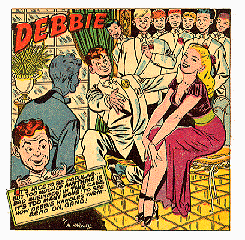 In 1946 Hartley contributed to All Humor Comics published by Quality Comics. He also wrote and drew the 8-page "
Roger Dodger" feature
in
Exciting Comics for Better/Nedor/Standard Publishing. His work on this bimonthly comic spanned from at least issue #51 (Sept. 1946) through issue # 67 (May 1949). He also did 1 and 2-page funny features for this company, in their quarterly America's Best Comics from # 20 (December 1946) to # 28 (November 1948). Hartley contributed to Better/Nedor/Standard's Startling Comics and Wonder Comics titles in '47 and '48, too.
In 1946 Hartley contributed to All Humor Comics published by Quality Comics. He also wrote and drew the 8-page "
Roger Dodger" feature
in
Exciting Comics for Better/Nedor/Standard Publishing. His work on this bimonthly comic spanned from at least issue #51 (Sept. 1946) through issue # 67 (May 1949). He also did 1 and 2-page funny features for this company, in their quarterly America's Best Comics from # 20 (December 1946) to # 28 (November 1948). Hartley contributed to Better/Nedor/Standard's Startling Comics and Wonder Comics titles in '47 and '48, too.
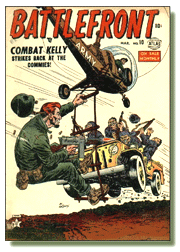
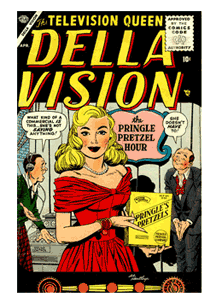 By the mid 1950's, Hartley was contributing to such unusual comics as Man! Dig This CRAZY Little Mixed-Up Mag!, World's Greatest Songs, Wild! ("Shiver and Shake... Laugh and Quake!"), 3-D Tales of the West, and Della Vision, TV Queen (Hartley's cover for issue #1/April 1955 shown right). Jungle comics were big during that time, inspired by the Tarzan films, and Hartley drew comics such as Lorna the Jungle Girl
, "Leopard Girl" for Jungle Action, and also "
Cliff Mason, White Hunter" in
Jungle Tales. The horror and mystery comics were gaining in popularity as well, and Hartley contributed to Mystic, Spellbound, Strange Tales, Adventures Into Terror, and Mystery Tales. By 1954 he had begun working on
Girls' Life ("Patsy Walker's Own Magazine for Girls!").
By the mid 1950's, Hartley was contributing to such unusual comics as Man! Dig This CRAZY Little Mixed-Up Mag!, World's Greatest Songs, Wild! ("Shiver and Shake... Laugh and Quake!"), 3-D Tales of the West, and Della Vision, TV Queen (Hartley's cover for issue #1/April 1955 shown right). Jungle comics were big during that time, inspired by the Tarzan films, and Hartley drew comics such as Lorna the Jungle Girl
, "Leopard Girl" for Jungle Action, and also "
Cliff Mason, White Hunter" in
Jungle Tales. The horror and mystery comics were gaining in popularity as well, and Hartley contributed to Mystic, Spellbound, Strange Tales, Adventures Into Terror, and Mystery Tales. By 1954 he had begun working on
Girls' Life ("Patsy Walker's Own Magazine for Girls!").
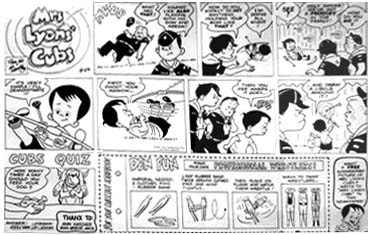
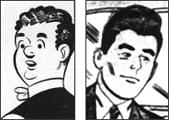
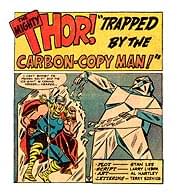
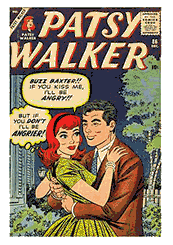
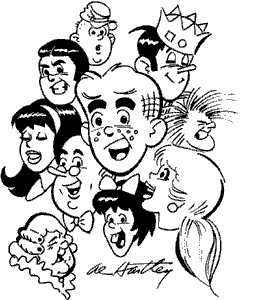
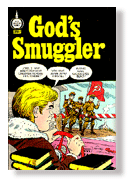
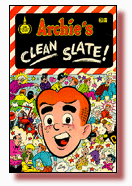
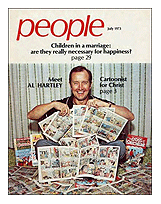
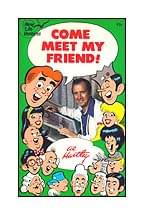
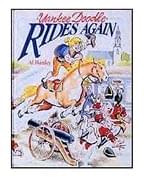
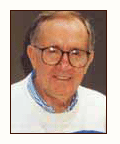 In recognition of his impact in the field of comics, Hartley is listed in The Who's Who of American Comic Books. He has also made an impact through his inspiration of many other artists and writers in the field. Archie's premiere penciller Stan Goldberg considers Hartley to be one of his big artistic influences and has called him, "one of the most versatile and talented men to ever work in comics."
Betty & Veronica scripter
In recognition of his impact in the field of comics, Hartley is listed in The Who's Who of American Comic Books. He has also made an impact through his inspiration of many other artists and writers in the field. Archie's premiere penciller Stan Goldberg considers Hartley to be one of his big artistic influences and has called him, "one of the most versatile and talented men to ever work in comics."
Betty & Veronica scripter